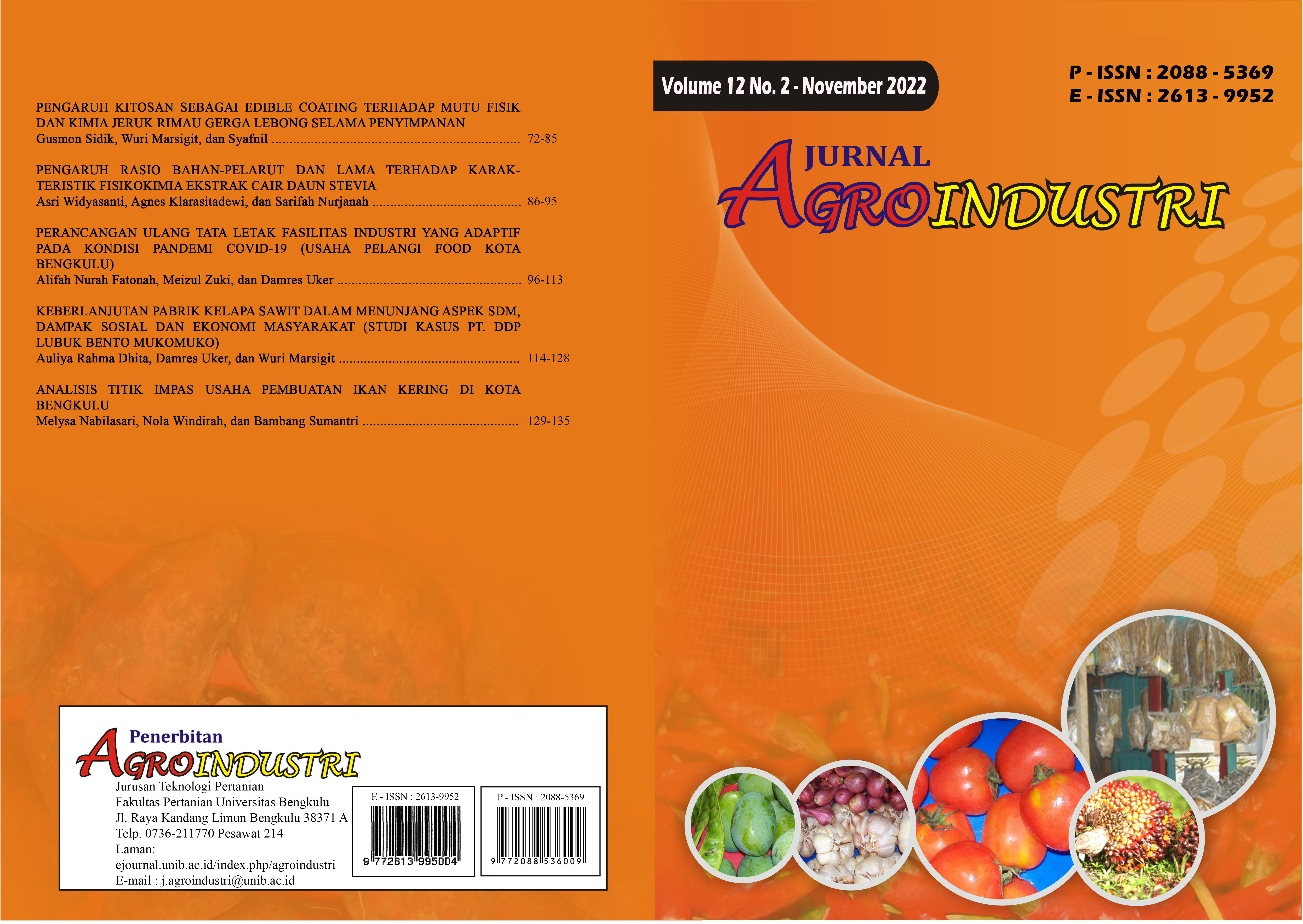Main Article Content
Abstract
Communities around PT. Darian Dharma Patama works as an employee at the company, manages his oil palm plantation, and trades. Local community work before PT. Darian Dharma Pratama stood, namely gardening and farming. The development of palm oil mills has positive and negative impacts on the community around the location of PT. DDP Lubuk Bento Mukomuko. This study aims to determine the palm oil mill based on aspects of the company's human resources, social and economic impact of the community around the location. This research uses trigulation technique combining primary and secondary data collection. In this study using random sampling and sampling in this study using the possibility of sampling with simple random sampling that is taking randomly from the population. The data comes from the form of numbers but from interviews with informants and official company documents. This type of research uses descriptive research with facts and correct interpretation, by studying the data obtained through interviews and company documents, regarding the activities that exist in the company, the relationship between the company and the community. The results of this study PT. Darian Dharma Pratama Lubuk Bento in the aspect of company human resources, namely implementing an SOP system in the form of companies providing training and development to employees. While the results of the company's Social Impact are providing assistance in the form of CSR to the community and the economic impact of the community, namely the company providing job opportunities to be able to change the standard of living of the community. Therefore PT. Darian Dharma Pratama can be said to be sustainable in terms of Human resources Aspects, Social Impacts and Economic Impacts on the community around the factory location.
Article Details
Copyright (c) 2022 Auliya Rahma Dhita

This work is licensed under a Creative Commons Attribution-ShareAlike 4.0 International License.
Authors who publish in this journal agree with the following terms:
- Authors retain copyright and grant the journal right of first publication with the work simultaneously licensed under a Creative Commons Attribution License that allows others to share the work with an acknowledgment of the work's authorship and initial publication in this journal.
- Authors are able to enter into separate, additional contractual arrangements for the non-exclusive distribution of the journal's published version of the work (e.g., post it to an institutional repository or publish it in a book), with an acknowledgment of its initial publication in this journal.
- Authors are permitted and encouraged to post their work online (e.g., in institutional repositories or on their website) prior to and during the submission process, as it can lead to productive exchanges, as well as earlier and greater citation of published work (See The Effect of Open Access).
- This work is licensed under a Creative Commons Attribution-ShareAlike 4.0 International License.
References
- Bintarto, 1983. Interaksi Desa-Kota dan Permasalahannya. Ghalia Indonesia. Yogyakarta. 366 Halaman
- Cahayani, A. 2005.Strategi dan Kebijakan Sumber Daya Manusia. Jakarta. PT. Indeks. Anggota IKAPI. 1(2): 1-2
- Desai, P., & Chandawarkar, M. R. 2015.CSR Practices and Sustainability of Health Care Organizations. Journal of Exclusive Management Science.4(8): 4–9
- Ngadi, M..N. 2015. Keberlanjutan Perkebunan Kelapa Sawit Di Indonesia Dan Prospek Pengembangan di Kawasan Pebatasan. Jurnal Agribisnis Indonesia. 43(1): 17-32
- McKenna dan Beech. 2000. The Essence of Manajemen Sumber Daya Manusia. diterjemahkan Totok Budi Santosa. Yogyakarta. 249 Halaman
- Ranjabar, J. 2013. Sistem Sosial Budaya Indonesia Suatu Penerapan . PT. Ghalia Indonesia. Bogor. 262 Halaman
- Rangan, K., Chase, L. A., & Karim, S. 2012. Why Every Company Needs a CSR Strategy and How to Build It.Journal of Exclusive Management Science. 7(2): 367-368
- Simamora, Henry. 2004. Manajemen Sumber Daya Manusia. Cetakan 3 STIE YKPN. Yogyakarta. 3(1) : 63-73
- Sugiyono. 2009. Metode Penelitian Bisnis Pendekatan kuantitatif, kualitatif dan R&D. Alfabeta. Bandung. 18(2) : 89-97
- Sumarto, S., & Suryahadi, A. 2004. Trade, Gowth, and Poverty In Indonesia. National Conference Of The University Outreach Network. Bogor. 30 Halaman.
- Untung, B. 2007.Corporate Social Responsibillity Perusahaan. Grafika Offset. Jakarta. 18 (1): 76-80
- Warhust, A. 20020. Sustainabillity Indicators And Sustainabillity Performance Management. Warwick Business School. Inggris. 5(2) : 100-101
- Widodo, T. 2007. Perencanaan Pembangunan. UPP STIM YKPN. Yogyakarta. 2(2) : 1-5
References
Bintarto, 1983. Interaksi Desa-Kota dan Permasalahannya. Ghalia Indonesia. Yogyakarta. 366 Halaman
Cahayani, A. 2005.Strategi dan Kebijakan Sumber Daya Manusia. Jakarta. PT. Indeks. Anggota IKAPI. 1(2): 1-2
Desai, P., & Chandawarkar, M. R. 2015.CSR Practices and Sustainability of Health Care Organizations. Journal of Exclusive Management Science.4(8): 4–9
Ngadi, M..N. 2015. Keberlanjutan Perkebunan Kelapa Sawit Di Indonesia Dan Prospek Pengembangan di Kawasan Pebatasan. Jurnal Agribisnis Indonesia. 43(1): 17-32
McKenna dan Beech. 2000. The Essence of Manajemen Sumber Daya Manusia. diterjemahkan Totok Budi Santosa. Yogyakarta. 249 Halaman
Ranjabar, J. 2013. Sistem Sosial Budaya Indonesia Suatu Penerapan . PT. Ghalia Indonesia. Bogor. 262 Halaman
Rangan, K., Chase, L. A., & Karim, S. 2012. Why Every Company Needs a CSR Strategy and How to Build It.Journal of Exclusive Management Science. 7(2): 367-368
Simamora, Henry. 2004. Manajemen Sumber Daya Manusia. Cetakan 3 STIE YKPN. Yogyakarta. 3(1) : 63-73
Sugiyono. 2009. Metode Penelitian Bisnis Pendekatan kuantitatif, kualitatif dan R&D. Alfabeta. Bandung. 18(2) : 89-97
Sumarto, S., & Suryahadi, A. 2004. Trade, Gowth, and Poverty In Indonesia. National Conference Of The University Outreach Network. Bogor. 30 Halaman.
Untung, B. 2007.Corporate Social Responsibillity Perusahaan. Grafika Offset. Jakarta. 18 (1): 76-80
Warhust, A. 20020. Sustainabillity Indicators And Sustainabillity Performance Management. Warwick Business School. Inggris. 5(2) : 100-101
Widodo, T. 2007. Perencanaan Pembangunan. UPP STIM YKPN. Yogyakarta. 2(2) : 1-5
